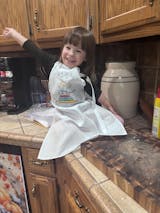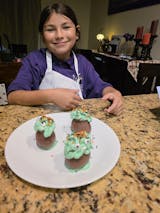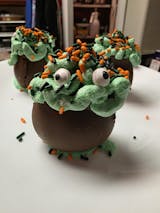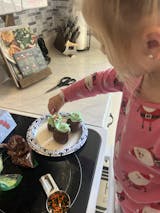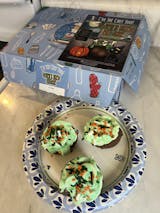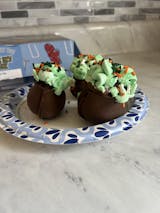Table of Contents
- Introduction
- The Marvel of Stacking: More Than Just Play
- The STEM Principles Behind Every Stack
- Different Types of Stack 'Em Up STEM Activities
- Why Incorporate Stack 'Em Up Activities into Your Child's Routine?
- Integrating Our STEM Cooking Kits for Stack 'Em Up Fun
- Practical Tips for Parents and Educators
- Beyond the Home: Stack 'Em Up in Educational Settings
- Our Philosophy: Blending Food, STEM, and Art
- Conclusion
- FAQ: Your Stack 'Em Up STEM Activity Questions Answered
Introduction
Have you ever watched your child meticulously arrange building blocks, trying to make the tallest tower possible before it inevitably topples? Or perhaps you've seen them carefully layer ingredients in a play kitchen, mimicking your every move? This natural inclination towards stacking, building, and arranging is more than just play; it's the foundation for a powerful stack em up STEM activity experience that ignites curiosity and critical thinking. In a world increasingly dominated by screens, finding engaging, hands-on activities that foster genuine learning can feel like a quest. This post isn't just about stacking blocks; it’s a deep dive into how the simple act of putting things together, layer by layer, can unlock fundamental principles of Science, Technology, Engineering, and Math. We'll explore the incredible educational benefits of these activities, offer practical ways to bring them to life at home and in educational settings, and reveal how "stack em up" concepts are woven into the very fabric of our unique cooking STEM adventures. Our mission at I'm the Chef Too! is to blend food, STEM, and the arts into one-of-a-kind "edutainment" experiences, proving that learning complex subjects can be tangible, hands-on, and utterly delicious. By the end of this guide, you’ll be equipped with insights and inspiration to turn everyday stacking into extraordinary learning opportunities, fostering a love for discovery that truly lasts.
The Marvel of Stacking: More Than Just Play
When children engage in a stack em up STEM activity, they are not merely playing; they are conducting mini-experiments, testing hypotheses, and solving real-world problems. The allure of building something tall, stable, or intricately layered captures their attention and stimulates their minds in profound ways. From toddlers attempting to balance a single block on another to older children constructing elaborate marble runs, the process of stacking inherently involves a series of challenges and triumphs that build essential skills.
Think about it: every time a child places one item on top of another, they are unconsciously exploring concepts like gravity, balance, weight distribution, and structural integrity. Will it stand? Why did it fall? How can I make it stronger? These aren't just questions; they are the bedrock of scientific inquiry and engineering design. The trial-and-error process involved in stacking teaches resilience and problem-solving. Failure isn't a setback; it's a valuable data point, guiding them toward a better solution. This iterative process is crucial for developing a growth mindset, encouraging them to persist even when faced with challenges.
Beyond the obvious physics and engineering principles, stacking activities also hone fine motor skills and hand-eye coordination. The delicate precision required to balance objects, especially as towers grow taller or layers become more intricate, refines dexterity. Spatial reasoning also gets a workout as children visualize how pieces fit together and how adjustments might affect the overall structure. This spatial awareness is fundamental for later learning in geometry, architecture, and even abstract mathematical concepts.
What makes a stack em up STEM activity particularly potent is its accessibility. You don't need fancy equipment or a specialized laboratory. Ordinary household items, natural materials, and even food can become tools for incredible learning adventures. This ease of access makes it simple for parents and educators to incorporate rich STEM experiences into daily routines, transforming playtime into impactful learning time without extra effort or expense.
The STEM Principles Behind Every Stack
To truly appreciate the power of a stack em up STEM activity, let's break down the core principles at play:
Science: Forces and Materials
Every stack is a living laboratory for physics. Children learn about:
- Gravity: The invisible force pulling everything downwards. They intuitively understand that heavier objects might need a stronger base, or that a tall, thin tower is more susceptible to gravity's pull.
- Friction: The resistance between surfaces. Why do some blocks slide off easily while others hold firm? This introduces the idea of different material properties.
- Balance and Center of Mass: Finding the sweet spot where an object can sit without toppling. Children learn to distribute weight evenly and adjust their placement to maintain equilibrium.
- Material Properties: How different materials behave. A stack of sponges will behave differently than a stack of wooden blocks or metal cans. This teaches about properties like density, rigidity, and flexibility.
Technology: Tools and Innovation
While stacking might seem low-tech, it inherently involves technological thinking:
- Tool Use: Whether it's using a ruler to measure the height of a tower or a spoon to layer ingredients precisely, children learn to use tools effectively to achieve a goal.
- Design and Iteration: Every stack is a design challenge. Children consider what "technology" or method will best achieve their desired outcome and then refine their approach based on what they observe. This iterative design process is central to technological advancement.
- Problem-Solving with Constraints: Stacking often comes with built-in challenges, like a limited number of blocks or a specific height target. Learning to work within these constraints and find creative solutions is a key technological skill.
Engineering: Design and Structure
This is where stacking truly shines as an engineering feat:
- Structural Integrity: How to build something that is strong and stable. Children experiment with different base sizes, interlocking patterns, and support structures to prevent collapse.
- Foundation and Load Bearing: Understanding that a strong base is crucial for supporting weight. They learn that wider bases or distributing weight across multiple points can create a more stable structure.
- Architectural Concepts: Exploring basic principles of architecture, such as how arches distribute weight or how different shapes (squares, triangles) offer varying degrees of stability.
- Problem Identification and Solution: When a stack falls, it's an engineering failure. The child then identifies why it fell and engineers a new solution, learning from their mistakes.
Mathematics: Measurement and Geometry
Math is woven into every aspect of a stack em up STEM activity:
- Counting and Quantity: Simple counting of how many items are in a stack or how many layers they've created.
- Measurement: Estimating and measuring height, width, and depth. Comparing sizes of different objects.
- Geometry: Recognizing and understanding shapes (squares, rectangles, cylinders, pyramids) and how they fit together. Exploring concepts like area and volume in a tangible way.
- Patterns and Sequences: Identifying repeating patterns in their stacks or following a sequence of instructions when layering.
- Estimation and Prediction: Predicting how many items can be stacked before it topples, or estimating the height of a finished structure.
By engaging in these seemingly simple activities, children are building a robust foundation in STEM, developing intuitive understandings that will serve them well in more formal learning environments later on. This hands-on, experiential learning is far more impactful than rote memorization, fostering true comprehension and a genuine love for discovery.
Different Types of Stack 'Em Up STEM Activities
The beauty of a stack em up STEM activity is its incredible versatility. It extends far beyond just building towers with blocks. Here are various ways to engage children in stacking, each offering unique learning opportunities:
1. Classic Tower Building
- Materials: Wooden blocks, LEGOs, cardboard boxes, plastic cups, rocks, books, even pillows.
- Focus: Stability, height, balance, base strength.
- Challenge Ideas: Build the tallest tower possible, build a tower that can withstand a "wind" (fan), build a tower with a specific number of items, build a tower using only items of one color or shape.
- Learning: Directly applies principles of gravity, center of mass, and structural engineering. Children learn about different foundational designs and how weight distribution affects stability.
2. Creative Stacking & Balancing
- Materials: Recycled materials (paper towel rolls, egg cartons), natural objects (pinecones, leaves, twigs), assorted household items (buttons, coins, plastic lids).
- Focus: Problem-solving, ingenuity, understanding irregular shapes, counterbalancing.
- Challenge Ideas: Stack items that aren't perfectly flat, create a freestanding sculpture, balance a surprising item on top of another, build a bridge that spans two points using only stacked items.
- Learning: Encourages out-of-the-box thinking and deeper understanding of how shapes interact. This is great for fostering resilience as failures often lead to more creative solutions.
3. Layering & Sequencing Activities
- Materials: Colored paper, fabric scraps, different types of pasta, multi-colored beads, even ingredients for snacks!
- Focus: Patterns, sequences, organization, measurement, visual design.
- Challenge Ideas: Create a pattern with stacked colors or shapes, layer different textures, build a "sandwich" following a specific order.
- Learning: Introduces mathematical concepts of patterning and sequencing, as well as artistic design principles. This type of activity bridges STEM with the arts, aligning perfectly with our "edutainment" philosophy at I'm the Chef Too!.
4. Edible Stacking Adventures
This is where I'm the Chef Too! truly shines! Our unique approach blends the joy of cooking with robust STEM learning, making edible stacking a fantastic stack em up STEM activity. When children are in the kitchen, they're not just making food; they're experimenting with chemistry, measuring with precision, and engineering delicious structures.
-
Layering Ingredients:
- Desserts: Think parfaits, trifles, multi-layered cakes, or even ice cream sundaes. Children measure liquids and solids, learn about density (why oil and water separate, or how heavier fruit sinks in a parfait), and understand how different textures complement each other.
- Savory: Building sandwiches or wraps, creating lasagna layers, or constructing a seven-layer dip. This involves spatial planning and understanding how ingredients fit together.
-
Building Edible Structures:
- Cookie Towers: How high can you stack cookies before they crumble? This is a delicious challenge in structural integrity.
- Gingerbread Houses: The ultimate edible engineering project, requiring precision, stability, and understanding of adhesives (icing!).
- Marshmallow and Toothpick Structures: Building 3D shapes and towers, demonstrating geometric principles and the strength of different forms.
- Our Kits: Many of our cooking adventures naturally involve stacking and layering. For instance, creating our Erupting Volcano Cakes involves carefully layering ingredients for the chemical reaction that makes it bubble over. With our Galaxy Donut Kit, kids explore astronomy by creating their own edible solar system, which includes layering glazes and sprinkles for a multi-dimensional effect. Even beloved characters can make learning fun, like when kids make Peppa Pig Muddy Puddle Cookie Pies which involves carefully layering cookies and delicious filling.
Edible stacking activities provide immediate, delicious gratification, reinforcing the learning in a positive and memorable way. They transform abstract concepts into tangible, tasty results. This hands-on experience is exactly what we champion at I'm the Chef Too!, ensuring that every adventure sparks curiosity and creativity while fostering family bonding.
Why Incorporate Stack 'Em Up Activities into Your Child's Routine?
Integrating a stack em up STEM activity into your child's playtime offers a multitude of benefits that extend far beyond simply keeping them occupied. These activities are powerful tools for holistic development:
Fostering Critical Thinking and Problem-Solving
Every collapse of a block tower or wobbly edible creation presents a challenge. Children are forced to analyze what went wrong and devise a new strategy. "Why did it fall?" "How can I make it stronger?" These questions are the essence of critical thinking. They learn to identify problems, brainstorm solutions, test them out, and iterate. This resilience in the face of failure is perhaps one of the most important life skills these activities teach. It’s about understanding that mistakes are opportunities for learning, not reasons to give up.
Developing Fine Motor Skills and Hand-Eye Coordination
The precision required to place one item carefully atop another, especially as the stack grows taller or more complex, significantly refines fine motor skills. This delicate manipulation strengthens the small muscles in the hands and fingers, which are crucial for tasks like writing, drawing, and even tying shoelaces. Simultaneously, hand-eye coordination improves as children learn to accurately guide their movements based on what their eyes perceive.
Enhancing Spatial Reasoning
Spatial reasoning is the ability to visualize and manipulate objects in space. When building, children mentally rotate and fit pieces together, predict how they will balance, and understand concepts like height, width, and depth. This skill is foundational for subjects like geometry, physics, and even navigating physical environments. A child who excels at spatial reasoning might easily grasp concepts like mapping or understanding architectural blueprints later in life.
Encouraging Creativity and Imagination
While stacking might seem rigidly structured, there’s immense room for creativity. Children can design unique structures, experiment with different materials, and imagine the purpose of their creations (e.g., "This is a castle for my toy knight!"). This free play encourages imaginative thinking and allows children to express themselves through their constructions. There's no single "right" way to stack, which empowers them to explore and innovate.
Building Patience and Perseverance
Tall stacks don't happen instantly. They require focus, concentration, and repeated attempts. When a tower tumbles, children learn to cope with frustration, regroup, and try again. This process cultivates patience and perseverance, teaching them that sustained effort often leads to success. It’s a powerful lesson in delayed gratification and the rewards of sustained work.
Promoting Communication and Collaboration
When children engage in stack em up STEM activity together, they naturally practice communication and collaboration. They might discuss strategies, share materials, or work together to achieve a common goal. This fosters teamwork, negotiation skills, and the ability to articulate their ideas, all essential for social and academic success.
Providing Screen-Free Engagement
In an age dominated by digital distractions, hands-on activities offer a much-needed screen-free alternative. They engage multiple senses, provide tangible results, and encourage physical interaction with the world. This type of play is crucial for healthy brain development and for fostering a child's natural curiosity about their physical environment. At I'm the Chef Too!, we are committed to providing these screen-free educational experiences, allowing children to discover the magic of learning through tangible, delicious adventures. Ready for a new adventure every month? Join The Chef's Club and enjoy free shipping on every box.
Integrating Our STEM Cooking Kits for Stack 'Em Up Fun
At I'm the Chef Too!, our core mission is to blend food, STEM, and the arts into one-of-a-kind "edutainment" experiences. We believe that some of the most profound learning happens when children are actively engaged, using their hands and their senses, and when the lessons are literally delicious! Our cooking STEM kits are perfectly designed to support the principles of a stack em up STEM activity in a fun, engaging, and memorable way. Developed by mothers and educators, our kits ensure that learning is both impactful and enjoyable.
How do our kits incorporate "stack 'em up" concepts?
- Measurement and Precision (Math & Science): Many recipes require precise measurement of ingredients for layering. Children learn about volume, weight, and fractions as they measure flour, sugar, or liquids. The success of a layered cake or a perfectly portioned parfait depends on accurate measurements, reinforcing mathematical concepts in a practical setting. For instance, when creating our Fudgy Fossil Dig kit, the precise layering of different ingredients contributes to the 'dig site' effect, making measurement a key part of the fun.
- Chemical Reactions and Density (Science): Our kits often involve chemical reactions, and some of these require careful layering. Understanding density is crucial for activities like making layered drinks or parfaits, where liquids and solids of different densities stack up. For example, our Erupting Volcano Cakes kit is a prime example of a chemical reaction where ingredients are stacked or combined in specific ways to create the desired bubbling effect. This isn't just baking; it's hands-on chemistry!
- Structural Design and Stability (Engineering): When decorating a cake, building a cookie tower, or assembling edible structures, children engage in fundamental engineering principles. They consider how to support weight, how to make a stable base, and how to "glue" pieces together (with icing!). Our kits provide the materials and guidance to embark on these delicious engineering challenges. Imagine building a towering cupcake creation or a multi-tiered dessert—it’s all about edible engineering!
- Artistic Design and Aesthetics (Art): Layering isn't just about function; it's about beauty. Children experiment with colors, textures, and patterns to create visually appealing edible masterpieces. This integrates the "arts" component of STEM (STEAM), allowing for creative expression alongside scientific discovery. Our Galaxy Donut Kit provides an amazing opportunity for this, as children layer different colored glazes and sprinkles to create a beautiful, cosmic effect.
- Following Instructions and Sequencing (Technology & Logic): Recipes are essentially algorithms. Following step-by-step instructions to layer ingredients in the correct order teaches children about sequencing, logical thinking, and the importance of process—key components of technological literacy.
Our kits deliver pre-measured dry ingredients and specialty supplies right to your door, making it incredibly convenient to embark on a new STEM adventure every month. We take the guesswork out of planning, allowing you to focus on the joy of creating and learning with your child. Not ready to subscribe? Explore our full library of adventure kits available for a single purchase in our shop. You can Browse our complete collection of one-time kits to find the perfect theme for your little learner!
Practical Tips for Parents and Educators
Making a stack em up STEM activity a success isn't just about providing materials; it's about creating the right environment and guidance. Here are some practical tips to maximize the learning and fun:
1. Prioritize Safety
Especially with edible stacking or activities involving smaller parts, supervision is key. Ensure materials are age-appropriate and that any cooking involves adult oversight. For example, when using ovens or hot liquids, always have an adult present. Our kits come with clear instructions to guide safe fun in the kitchen.
2. Encourage Exploration, Not Perfection
The goal isn't to build the tallest, most perfect tower or the most aesthetically flawless layered dessert. The goal is the process of exploration, trial, and error. Celebrate the effort and the learning, even if the stack tumbles or the layers aren't perfectly even. Frame "failures" as learning opportunities. "Oh, it fell! What do you think happened? What could we try differently next time?" This fosters resilience and a love for learning.
3. Ask Open-Ended Questions
Instead of simply telling them what to do, prompt children with questions that encourage critical thinking:
- "What do you notice when you stack these?"
- "Which shape do you think would make the best base?"
- "Why do you think that layer sank/floated?"
- "How could we make this structure stronger/taller?"
- "What happens if we put the heaviest item on top?"
These questions guide their observations and help them articulate their thought process.
4. Provide a Variety of Materials
Don't limit yourself to just one type of building block. Offer a diverse range of materials—different sizes, shapes, weights, and textures. This expands their understanding of material properties and encourages more creative problem-solving. Think blocks, cups, cardboard, craft sticks, sponges, fruit, cookies, and more!
5. Document the Learning
Take photos or videos of their creations, especially their "epic fails" and subsequent successes. This provides a visual record of their progress and a chance to reflect on their learning journey. You can even create a "science journal" where they draw their designs and note their observations.
6. Connect to Real-World Examples
Help children see how stacking and layering relate to the world around them. Point out how buildings are constructed, how bridges are engineered, or how a rainbow cake is layered. This makes the learning relevant and highlights the practical applications of STEM concepts. You might say, "Look at how that building is stacked! What kind of base do you think it has?"
7. Join The Chef's Club for Ongoing Adventures!
For consistent, high-quality, and fun stack em up STEM activity experiences, consider our monthly "Chef's Club" subscription. Each box is a complete experience, containing pre-measured dry ingredients and specialty supplies, delivered right to your door with free shipping in the US. It's the ultimate convenience for sparking ongoing curiosity and creativity. We offer flexible 3, 6, and 12-month pre-paid plans, perfect for gifting or long-term enrichment. Give the gift of learning that lasts all year with a 12-month subscription to our STEM cooking adventures! Join The Chef's Club today!
Beyond the Home: Stack 'Em Up in Educational Settings
The power of a stack em up STEM activity is not limited to home kitchens or playrooms. These versatile activities are incredibly valuable in formal and informal educational settings, offering hands-on learning that complements traditional curricula. Whether in a classroom, homeschool co-op, summer camp, or after-school program, stacking fosters collaboration, critical thinking, and applied STEM knowledge.
In the Classroom
- Science Experiments: Teachers can set up stations where students experiment with different materials to test stability, friction, or the effects of gravity. This could involve building towers with various base shapes or exploring how different liquids layer based on density.
- Engineering Challenges: Design challenges are a natural fit. Students can work in teams to build the tallest free-standing structure using limited materials (e.g., spaghetti and marshmallows, or index cards and tape). This encourages collaborative problem-solving, design thinking, and iterative improvement.
- Math Concepts: Stacking can be used to teach geometry (identifying shapes, understanding volume), measurement (comparing heights, calculating total weight), and even fractions (when dividing materials for layers).
- Integrating Our Programs: We've made it easy to bring our unique "edutainment" experiences into your educational environment. Our school and group programs offer flexible options, including kits with or without food components, to suit different needs and settings. This allows educators to facilitate engaging, hands-on STEM cooking adventures that reinforce curriculum concepts in a fun, tangible way. Learn more about our versatile programs for schools and groups, available with or without food components, by visiting our site: Learn more about our versatile programs for schools and groups.
In Homeschool Co-ops and Learning Pods
- Project-Based Learning: A "stack 'em up" project can span several weeks, moving from initial design and material exploration to building, testing, and presenting findings. This fosters deeper engagement and allows children to take ownership of their learning.
- Interdisciplinary Units: Combine stacking with history (e.g., building ancient structures), art (designing aesthetically pleasing towers), or even language arts (writing instructions for building a specific stack).
- Community Building: Collaborative stacking challenges can strengthen bonds within a co-op, teaching children how to work together, communicate effectively, and celebrate each other's successes.
In Camps and After-School Programs
- Engaging Activities: Stacking challenges are inherently fun and require active participation, making them perfect for keeping children engaged during non-traditional learning times. They provide a fantastic alternative to screen time and promote physical activity and creativity.
- Skill-Building Workshops: Offer dedicated workshops focused on specific aspects of stacking, such as "Bridge Building Basics" or "The Science of Stability."
- Showcasing Creations: Organize an exhibition where children can display their stacked creations and explain the STEM principles behind them. This builds confidence and provides a sense of accomplishment.
No matter the setting, the fundamental benefits remain: children learn by doing, by experimenting, and by experiencing the real-world implications of STEM principles. This hands-on approach, particularly when infused with the delicious and tangible outcomes of cooking, makes learning unforgettable. Consider how a stack em up STEM activity can enrich your educational program and provide truly unique, impactful experiences for your young learners.
Our Philosophy: Blending Food, STEM, and Art
At I'm the Chef Too!, our commitment goes beyond just providing materials; it's about fostering a unique learning philosophy. We firmly believe that the most effective and memorable education happens when it’s fun, hands-on, and relatable. That's why we blend food, STEM (Science, Technology, Engineering, and Math), and the arts into what we lovingly call "edutainment" experiences.
The concept of a stack em up STEM activity perfectly embodies this philosophy. When children are in the kitchen, carefully layering ingredients for a cake, assembling an edible structure, or measuring components for a chemical reaction, they are simultaneously engaging their senses, practicing fine motor skills, and applying complex scientific principles—all while expressing their creativity.
- Sparking Curiosity and Creativity: We don't just give kids a recipe; we give them an adventure. Each kit tells a story, whether it's exploring the cosmos with the Galaxy Donut Kit or uncovering prehistoric fun with our Fudgy Fossil Dig. This narrative approach sparks imagination and makes children eager to discover what comes next. The act of stacking and layering within these themes allows them to be the creators, pushing the boundaries of their ingenuity.
- Facilitating Family Bonding: In a busy world, finding quality screen-free time to connect as a family can be a challenge. Our kits provide a natural opportunity for parents and children to work together, learn together, and create together. The shared experience of a "stack em up" cooking adventure builds memories and strengthens relationships, making learning a joyful family affair.
- Providing a Screen-Free Educational Alternative: We champion tactile, experiential learning. Our hands-on cooking activities offer a refreshing break from digital devices, engaging children in a way that stimulates their minds and senses directly. The tangible results of their efforts—a delicious treat they can eat—provide immediate gratification and reinforce the learning in a powerful way.
- Unique Approach Developed by Mothers and Educators: We understand the needs of both children and parents because our kits are developed by those who know them best: mothers and educators. This unique perspective ensures that our activities are not only educational and developmentally appropriate but also practical for busy families. We focus on providing clear instructions, pre-measured dry ingredients, and specialty supplies to make the experience as seamless and enjoyable as possible.
We believe that learning should be an adventure, not a chore. By transforming fundamental STEM concepts into tangible, delicious "stack em up" cooking projects, we aim to cultivate a lifelong love for learning, build confidence in young minds, and create cherished family moments. We invite you to experience the magic of learning through our unique culinary creations. If you're looking for more exciting adventures, remember you can always Browse our complete collection of one-time kits in our shop!
Conclusion
The humble act of stacking, whether it's building blocks, carefully arranging natural objects, or layering delicious ingredients, is a powerful gateway to fundamental STEM learning. A stack em up STEM activity goes far beyond simple play; it's an immersive experience that teaches crucial concepts in science, technology, engineering, and mathematics, while simultaneously fostering critical life skills like problem-solving, resilience, fine motor control, and creativity. From understanding gravity and balance to mastering measurement and structural design, children gain invaluable hands-on experience that lays a strong foundation for future academic success and a lifelong love for discovery.
At I'm the Chef Too!, we are passionate about transforming these educational concepts into exciting, accessible, and utterly delicious adventures. Our unique blend of food, STEM, and the arts creates "edutainment" experiences that not only spark curiosity and creativity but also facilitate meaningful family bonding and provide a much-needed screen-free alternative for engaging young minds. We believe that learning is best when it's tangible, hands-on, and results in something as rewarding as a delicious treat.
Ready to turn your kitchen into a dynamic learning lab and embark on endless stacking and layering adventures? Don't miss out on the fun and learning that comes straight to your door every month.
Join The Chef's Club and start your child's next delicious STEM adventure today! Join The Chef's Club
FAQ: Your Stack 'Em Up STEM Activity Questions Answered
Q1: What age group is best suited for "stack em up" STEM activities?
A1: "Stack em up" STEM activities are wonderfully versatile and can be adapted for almost any age group, from toddlers to pre-teens. For toddlers, simple block stacking or large soft objects are great for developing basic motor skills and understanding cause and effect. Preschoolers can move on to more varied materials and simple engineering challenges. Elementary school children can engage in more complex structural designs, precise measurements, and understanding of concepts like weight distribution and chemical reactions in layered cooking. The key is to adjust the complexity of the materials and the guiding questions to match the child's developmental stage.
Q2: What if my child gets frustrated when their stack falls?
A2: Frustration is a natural part of the learning process, especially in activities involving trial and error. As parents and educators, our role is to help children navigate this. Acknowledge their frustration ("It's really hard when your tower keeps falling, isn't it?"). Then, gently guide them towards problem-solving. Ask open-ended questions like, "What do you think made it fall? What could we change next time?" or "Can we try a different shape for the base?" Emphasize that every fall is a chance to learn and that even engineers and scientists experience failures before they find success. Celebrating the effort and the learning process, rather than just the final product, is crucial.
Q3: How do I make everyday stacking activities more educational?
A3: The easiest way to elevate everyday stacking into a full-fledged stack em up STEM activity is through intentional observation and questioning. Instead of just letting them stack, engage with them. Ask them to predict ("How many more do you think you can stack?"), observe ("What do you notice about how the heaviest block feels on the bottom?"), compare ("Which tower is taller?"), and explain ("Why do you think this one stayed up and that one fell?"). Introduce measuring tools like rulers or measuring cups for cooking activities. Talk about the shapes they are using and how they fit together. Connecting the activity to real-world structures like buildings or bridges also adds an educational layer.
Q4: Are "stack em up" cooking activities messy? How do I manage that?
A4: Yes, cooking activities, especially with kids, can certainly be messy! However, the learning and fun are well worth it. To manage the mess, prepare your space beforehand: lay down newspaper or a washable mat, have wet cloths or paper towels readily available, and dress children in clothes that can get a little messy (or use an apron). Our I'm the Chef Too! kits come with pre-measured dry ingredients, which significantly reduces the number of containers and bags you need to open, thus minimizing potential spills. Focus on the process and remember that a little mess is often a sign of active, engaged learning!
Q5: How can I find more resources for STEM activities for my child?
A5: There are many resources available! Beyond the ideas presented here, libraries often have great books on kid-friendly science experiments. Educational websites and blogs (like ours!) are fantastic sources for new ideas. For a convenient and comprehensive solution, consider a subscription to a STEM kit service. At I'm the Chef Too!, our monthly Chef's Club boxes are specifically designed to bring exciting, hands-on STEM and art experiences right to your kitchen, all while focusing on delicious culinary creations. Each box is a complete adventure, taking the guesswork out of planning and providing all the specialty supplies and pre-measured dry ingredients you need. It’s a fantastic way to ensure a steady stream of engaging stack em up STEM activity and other STEM fun. Join The Chef's Club for free shipping in the US and endless learning adventures!


























